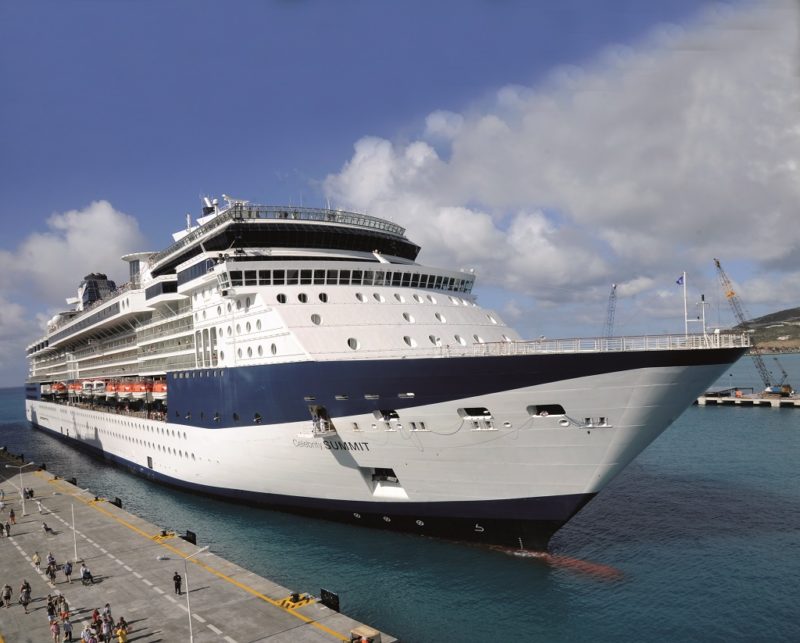
Despite being only 16 kilometres from west to east and only 12 kilometres from north to south, this small Leeward Island has been partitioned into French and Dutch sections since a Treaty was signed on 23rd March 1648 to allow the presence of both French and Dutch settlers on this sunny island in the Caribbean after a military struggle between both factions. There are many other islands throughout the world that have had dual nationality administrations for long periods. The seventy islands of the New Hebrides chain of islands in the South Pacific had dual British and French administrations from 1900 until independence was granted in 1974.
St. Martin/St. Maarten is the smallest island in the world with dual nationality, and St. Maarten is one of four independent countries alongside the Netherlands, Curaҫao and Aruba. The Princess Juliana International Airport on the island is only a short twenty minute taxi ride away from the port, with over one hundred taxis waiting at the airport and at the port every day, and with the island economy very heavily reliant on tourism, in excess of 88% of GDP. Princess Juliana Airport began life in 1943 as a base for American Army and Navy planes to hunt German U-boats off the islands. The French northern part of the island was until the referendum of 7th December 2003 a dependency of Guadeloupe, with both Martinique and Guadeloupe having the same status as all of the mainland France departments for modern services and financial grants. The French islanders voted for separation from Guadeloupe, both from an administrative and political viewpoint, and became self-governing with the population electing officials.
HISTORY AND SHIPPING OF ST. MARTIN/ST. MAARTEN
The second voyage of Colon (Christopher Columbus) saw him sail with his Spanish fleet on 10th November 1493 from Guadeloupe to the north west in search of the island of Hispaniola, and on this voyage he discovered several islands in the northern Leeward Islands. The peaceable native Arawak and more warlike Carib peoples lived on these islands from around 800 AD to 1500 AD, digging salt and existing on sweet potato, peanuts, cassava, tobacco, cotton and avocado. These people called the island under review as Sualouiga or ‘Salt Land’, which was renamed Santa Maria la Redonda or Sint Martin by Colon, as the day of its discovery was the feast day of Saint Martin of Tours.
At the start of the 17th century, the French were forced from Saint Kitts by the Spanish and took refuge on St. Martin. They formed the first permanent European settlement on the island. The Dutch also settled on ‘Salt Land’ in 1631, making St. Maarten the first Dutch colony in the Caribbean. The Dutch became great exporters of salt back to the Netherlands, and had built their homes and a small fort by 1632, where the remains of Fort Amsterdam currently exist today between Little Bay and Great Bay at Philipsburg. The twin nations of Dutch and French settlers traded salt and tobacco on the island, but in 1633 the Spanish returned and forced the evacuation of both the Dutch and the French. In 1644, Peter Stuyvesant, who later was in control of Nieuw Amsterdam (New York), led a force of 800 Dutch soldiers to re-capture the island, but as well as losing the battle he also lost a leg in the process.
However, the Spanish left the island of their own volition four years later in 1648, and after a brief military struggle between the Dutch and the French, the partition treaty was signed on Mount Concordia (Mont des Accords) with the French in control of the larger northern part of 21 square miles, and the Dutch in control of the smaller southern part of 16 square miles. French is spoken in the northern part, and Dutch in the southern part, and they have lived peaceably together in this way for almost the last four hundred years. There are no customs officials at the border between the two parts of the island, just a stone monument and signs in two languages at the side of the road.
The apocryphal legend of how the French part of the island became the larger part of the island is as follows. Between 1648 when the Dutch and the French signed the Treaty of Concordia in 1817, and when the borders of the island were set, the island changed government sixteen times. A march was then staged, and each commander selected a strong man. They were placed back-to-back at a fixed spot and ordered to march around the island in opposite directions. Where they met again would settle the boundary line. The Frenchman took his water bottle and stick and departed. The Dutchman took his water bottle and stick and departed, but also carried a flask of Dutch gin!
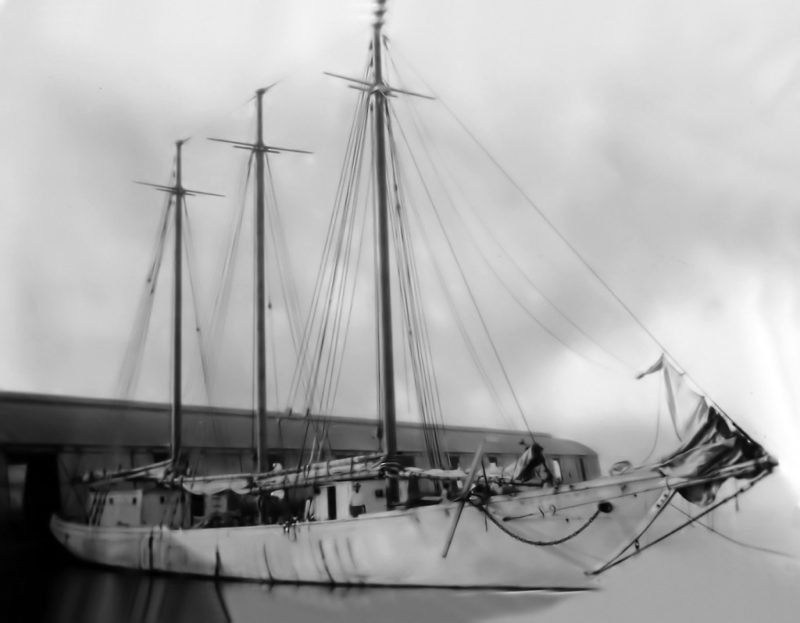
As they continued their journeys, the Frenchman quenched his thirst with water, but the Dutchman added a good portion of gin to his water. Overcome by the heat, the Dutchman decided to take a nap in the shade of a tree and soon fell sound asleep. His opponent in the meantime advanced several miles in his own direction, which proved detrimental to the Dutch and gave them only the smaller southern part of the island, while the French gained the larger northern part of the island. The dividing line runs through the middle of the large Simpson Bay Lagoon in the west of the island, and then up Marigot Hill and Flagstaff Hill before returning to sea level at the Oyster Pond on the east side of the island.
Until the start of World War II, salt was the main export of the island, exported to the Netherlands, U.S.A., Canada and South America. Men and women worked together so that the salt was graded and cleaned and placed in the bottom of flat-bottomed boats, and then rowed out to three masted sailing ships and two masted schooners in Great Bay Harbour.
Sometimes there were two yields of salt per year, all depending on the amount of rainfall. Fish, lobster, sugar cane and cotton were the other exports, with 35 sugar mills on the Dutch side of the border, compared to 27 on the French side. All over the island, the two nations laboured in the sugar cane fields including the Dutch and French Cul de Sac, the Fort Willem Hill and the Upper Princess Quarter. Salt, sugar, rum and gin was what the island became famous for internationally.
During World War I, the small islands of Anguilla, St. Marten, Saba and St. Eustatius all depended on St. Kitts & Nevis for food supplies by trading schooner as steamers did not call at these islands.
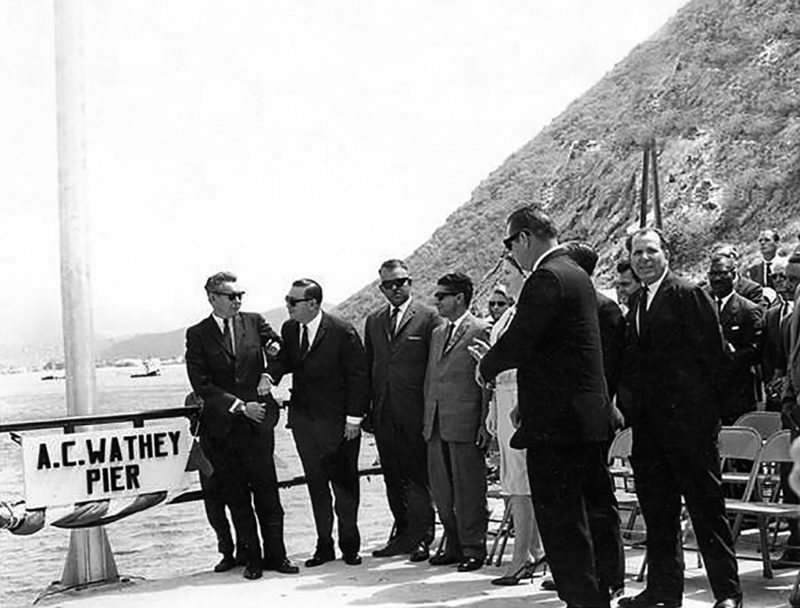
A Dutch Antilles Government owned trading schooner, the twin masted Estelle with a loaded draft of thirteen feet, traded to New York via St. Kitts with sugar and passengers and St. Maarten with passengers and salt from her purchase on 4th October 1918 until August 1922. Amongst the very many owner/skipper trading schooners in the Dutch Antilles were:-
The wooden Camia of 120 grt with dimensions of 78.1 feet by 22.2 feet for C.B. De Gorter, who also owned the schooner Meteor of 144 grt
Johanna of 143 grt owned by David Nesbith of St. Maarten on dimensions of 93.2 feet by 22.0 feet
The three masted Caribe of 249 grt built by Rene Hellmund at Curaҫao in 1921 with dimensions of 120.0 feet by 27.0 feet
Carlota of 117 grt from the same builder with dimensions of 86.0 feet by 22.0 feet
Themis of 125 grt from the same builder in 1913 with dimensions of 83.0 feet by 22.0 feet
Jupiter of 209 grt built in 1919 in the Cayman Islands with dimensions of 107.4 feet by 27.7 feet
Neerlandia of 141 grt built in 1918 at Bonaire by J. Craane with dimensions of 107.4 feet by 25.3 feet.
Mayflower of 164 grt built in 1921 at Gloucester (Mass.) with dimensions of 131.6 feet by 25.8 feet
However, auxiliary steam and motor engines were then fitted in many schooners, and there were equal numbers of powered and sailing schooners calling at Saba during the two years of 1933/34 with a total of one hundred small vessels. Larger four masted schooners T.N. Barnsdell owned by Capt. Ernest A. Johnson of Saba, and Margaret Throop and Robert Bean were used, as well as the three masted schooner Ina Vanterpool, lost at St. Eustatius in a hurricane on 15th September 1926. The last Saba mail schooners were Three Sisters of 191 grt built in 1917 with dimensions of 125.6 feet by 28.2 feet at Lunenburg (NS), which took over the mail service in 1929 until she was lost off St. Croix in 1932, and Blue Peter, which served from the end of World War II until around 1960.
KNSM of Holland had a big fleet of 82 steamers and two motor ships in 1930, and began a monthly Northern Dutch Antilles passenger and cargo service from Curaҫao on 11th November 1930 using the engines ‘midships steamer Baralt of 780 grt and built in 1921 at Montrose with an overall length of 200 feet and a bridge deck of length 60 feet, with a call also made at San Pedro de Macoris in the Dominican Republic. The service carried First Class and Deck Class passengers as well as coolies, and became solely for the islands of St. Maarten, St. Thomas, Saba and St. Eustatius as well as St. Kitts from 1st December 1931. The twin screw KNSM steamer Atlas of 1,277 grt built in 1922 by Deutsche Werft at Hamburg with dimensions of overall length 242.4 feet, moulded beam of 36 feet and moulded depth of 14.3 feet had a bridge deck of length 48 feet and a fo’c’stle of length 57 feet was also used. The quarter decker Midas of 962 grt built in 1925 at Elbing by F. Schichau as Ella Halm was also used during the 1930s with an overall length of 221.0 feet and a quarter deck of length 66 feet.
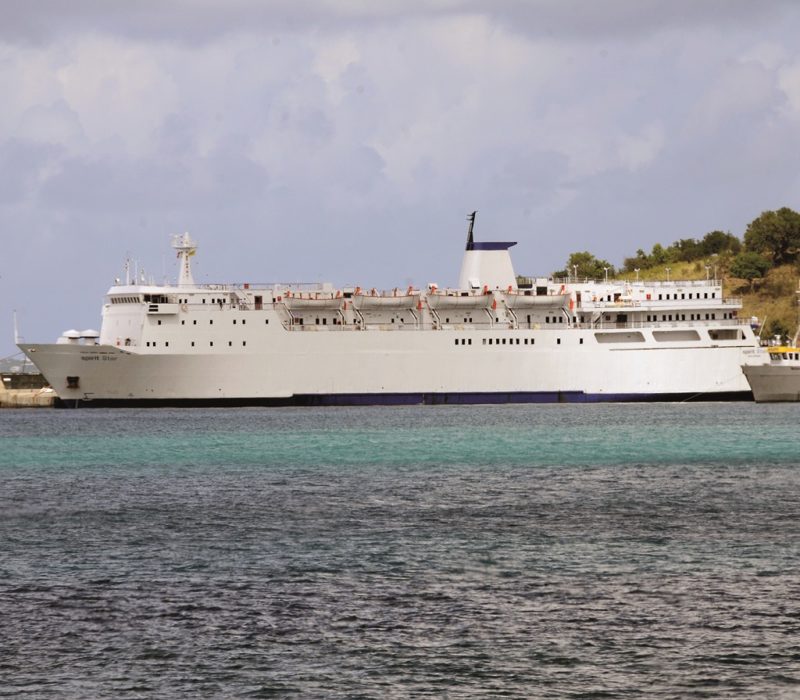
The twin screw KNSM steamer El Libertador of 1,713 grt was used from 1941 until 1948 during the constant threat of German U-boats. She was built in 1929 at Danzig as a new ship for KNSM to commemorate Simon Bolivar (1783-1830), the great Latin American hero and liberator of northern South America from the Spanish, and had a long bridge deck of 122 feet, overall length of 240.6 feet, moulded beam of 40.2 feet and a moulded depth of 12.3 feet. The service in 1951 began again with two identical sister motor coasters of 374 grt and both built in 1936 as Clio and Ino, until they were transferred in 1955 to the KWIS subsidiary company in Curaҫao, which also had a fleet of half a dozen coasters of 600 dwt with names ending in ‘o’ e.g. Dido, Draco, Flevo, Manto, Nero, Plato and Strabo.
The twin masted schooner Mona Marie was sunk by gunfire from a U-boat on 28th June 1942 while on a voyage from Barbados to Trinidad in ballast. Capt. Laurie of Saba and his crew managed to avoid the gunfire of the submarine as they escaped into a lifeboat from the trading schooner, and landed on the island of Mustique two days later. The schooner had been built in 1920 at Shelburne (NS) and was of 170 grt and 230 dwt but carried no bowsprit on the bow of her hull of dimensions 142 feet by 26 feet.
After World War II, the economy of the island was at its lowest point, and the island was denuded of strong men who left the island to work in the oil refineries on the Dutch Antilles of Aruba, Bonaire and Curaҫao, the ‘ABC’ islands to the south, with the crude oil brought to the surface by rigs in the shallow water of Lake Maracaibo in Venezuela, and then transported in shallow draft ‘mosquito’ tankers to the offshore ‘ABC’ refineries. The Queen Emma Pedestrian Bridge on the Punda waterfront at Willemstad in Curaҫao is a replacement for an earlier bridge built around 1903 to allow ships to pass up the narrow waterway up to St. Anna Bay and the Shell refinery. The Otrabanda district on the other side of St. Anna Bay now has more modern shopping streets such as Breedestraat (Broad Street). The remainder of the St. Maarten men left for the Dominican Republic to work in the sugar plantations, or left for the more varied work in the busy quarters of New York. Thus, the population of St. Maarten declined in the 1950s to around 1,500.
In the 1950s, 1960s and 1970s decades, a joint four-weekly Lesser Antilles service was operated by KNSM of Holland and Harrison Line of Liverpool to the island with limited passenger accommodation. Hamburg, Bremen, Amsterdam and Rotterdam (KNSM) or Liverpool (Harrison Line) called at Pointe a Pitre (Guadeloupe), Fort de France (Martinique), Port of Spain (Trinidad), St. George (Grenada), Kingstown (St. Vincent), Castries (St. Lucia), Roseau (Dominica), St. Johns (Antigua), Basseterre (St. Kitts), and Philipsburg (St. Maarten). The five hold T. & J. Harrison cargo liner Diplomat of 8,202 grt and 9,770 dwt completed in 1953 by the Doxford yard at Pallion in Sunderland called if there was sufficient cargo inducement.
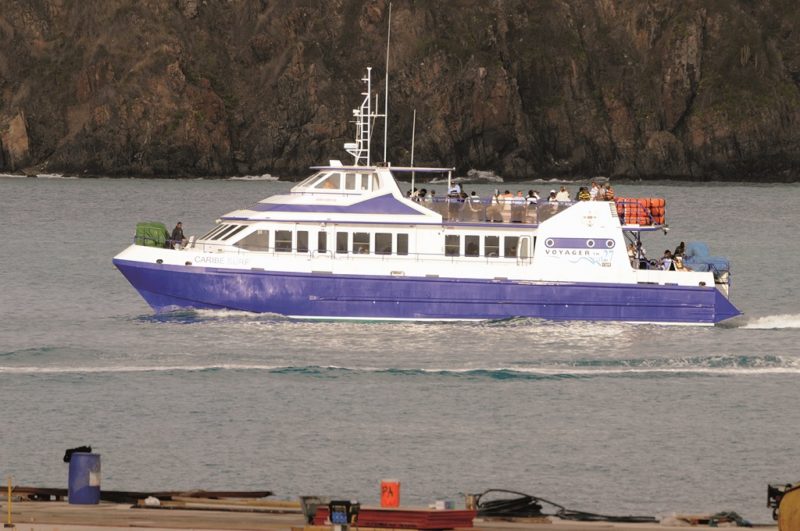
The thirteen members of the ‘Achilles’ class of KNSM of 6,236 grt and 7,780 dwt with a loaded draft of 24.5 feet and built between 1959 and 1963 were the main deep sea callers, with the names of Achilles, Archimedes, Ares, Aristoteles, Ceres, Diogenes, Ganymedes, Hercules, Hermes, Palamedes, Pericles, Socrates and Ulyssses. They had an overall length of 424 feet, moulded beam of 57 feet with three holds in front of the navigating bridge and one hold aft, and a service speed of 16.5 knots from a Stork diesel engine. Their regular route was from Amsterdam to St. Maarten, San Juan, Santo Domingo, Puerto Cortes (Honduras), La Ceiba (Honduras), Belize, Puerto Barrios (Guatemala), Santo Tomas de Castilla (Guatemala) and return to Amsterdam. This class also sailed on two other routes to the Caribbean, Central and South America without a call at St. Maarten, thus the number of calls at St. Maarten per year was restricted.
However, only this KNSM class and a very few other deep sea cargo ships arrived per year in the Port of Philipsburg, plus a fleet of small inter-island schooners. The Lesser Antilles comprise both the Leeward Islands and the Windward Islands, with the Leeward Islands being defined as all the islands to the south of the Sombrero Passage, near the British island of Sombrero, up to and including Dominica, and the Windward Islands as all those to the south of Dominica i.e. Martinique, St. Lucia, St. Vincent and the Grenadines, Barbados and Grenada.
The Dutch were the first of the two nations to realise and recognise the potential of the abundantly sunny climate of St. Maarten to tourism. The French soon followed, and in 1960 a fledgling tourism industry began to become the main source of income for the whole island. The friendliness of the people, the duty-free shops of Philipsburg, with a mile long white and yellow sandy beach on the southern coast of the Dutch part, and the shallow blue waters of Marigot Bay on the West side of the French part attracted tourists from the U.S.A. and Canada. The official currencies of the island are the Dutch Antillean guilder on the Dutch side and the Euro on the French side, but the American dollar is much more frequently used on both sides of the border as it is much more easily changed internationally.
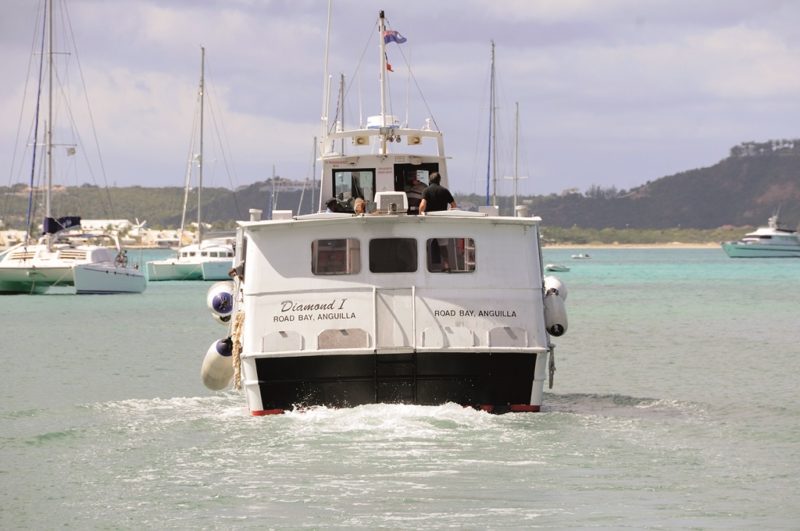
THE START OF BUILDING THE CRUISE PORT
The capital city of Dutch Sint Maarten is Philipsburg, named after Capt. John Philips of Scottish descent but serving at the time in the Dutch Navy, located on a narrow strip of land that separates the sea and the lovely white and yellow sandy beach from a large marshy inland pond called the Great Salt Pond, and actively mined until 1949. Four roads run from one end of the town to the other, with Front Street brimming with beach cafes, restaurants, casinos and duty-free shops. Beautiful wooden sidewalks have been added with palm trees and decorated lampposts and signs to please the eyes of the tourists. Sand dredged from the bottom of the sea was spread on Great Bay Beach, which flaunts a very impressive boardwalk. Cyrus Wathey Square on Front Street, across from Capt. Hodge Pier, has a striking white courthouse, built in 1792 by the Dutch commander Willem Hendrik Rink. Two of the other three streets of the town are pedestrianised for the safety of the thousands of tourists that throng the area.
Flavoured liqueurs from the local guavaberry fruit are the chief product on sale in the Guavaberry Emporium, a wooden cedar townhouse built in 1790, alongside other island drinks and products in Philipsburg. A restored 19th century townhouse is the setting of the Sint Maarten Museum, displaying many local historic artefacts such as an Arawak progue (canoe) standing upright at the entrance, a big photographic collection of island life in the early 1900s, and rescued artefacts from the sunken Dutch frigate Proselyte, which sank off Fort Amsterdam in 1801. Fort Amsterdam was built in 1631 by the Dutch and Fort Willem by the British in 1801, and are the twin former military landmarks of the island. Forest trekking in the foothills of Pic du Paradis (1,400 feet), the tallest peak on the island, and touring restored sugar plantations are two of the many tourist attractions. Day tours of former sugar plantations with a meal at the end in the large plantation guesthouse are a feature of all of the Leeward and Windward Islands.
Construction of the first of two long cruise piers began to the east of the mile long sandy beach of Philipsburg on a peninsula known as Pointe Blanche. The pier of 545 metres in length juts out at an angle from the shore to the south west, and was opened on 3rd June 1964 as the A.C. (Claude) Wathey Pier by a large group of invited local and international port officials to unveil a sign stating ‘A.C. WATHEY PIER’. Thereafter, cruise ship tourism began to slowly grow, with the total of 105,000 tourists per year reached in the early 1980s, rising to the total of one million welcomed in 2002, and thereafter the yearly figure of cruise passengers welcomed has been above one million per year. The ongoing total of cruise passengers welcomed to the island since 1964 is now 35 million. Many American tourists changed to having holidays on St. Maarten after the U.S. embargo on Cuba in 1960, and they stayed at small hotels in Philipsburg and Marigot.
The first cruise ship to homeport at St. Maarten was Carib Vacationer between 1986 and 1992 for Vacation Lines B. V. of the Netherlands. She was of 2,430 grt and had been built in 1971 by the De Merwede yard at Hardinxveld as the coastal cargo ship Craigavon. She was rebuilt in 1981 as the cruise ship Vacationer at Rotterdam, with accommodation for only 150 cruise passengers, and made seven day Mediterranean cruises from Malaga. In 1986, she was renamed Carib Vacationer for seven day cruises homeported at St. Maarten, which lasted until 1992, when she was renamed Coral Princess at Willemstad on Curaҫao. She still survives but is currently laid up.
A second long cruise ship pier of 445 metres in length was necessary to berth up to eight cruise ships on two piers on any one day. Planning for its construction started after the destructive Hurricane Luis of 1995 caused devastation to the island infrastructure, and the A.C. Cruise Pier South was put into operation in 2007. The Capt. David Cargo Pier was also brought into operation at this time, with the marine development of harbour related projects completed over 55 years by the Port St. Maarten Group of thirteen companies employing seventy people. The cargo part of the port uses two mobile cranes to load and unload TEU containers, project cargo, and the very useful smaller dimension than TEU container sized containers of the ‘800 series’ containers. A container and cargo storage yard receives cargo from Miami (1,136 miles away), the Panama Canal (1,108 miles distant), Freeport in the Bahamas (1,029 miles distant), Cartagena in Colombia (867 miles distant), Kingston on Jamaica (803 miles distant), Caucedo in the Dominican Republic (397 miles distant), Port of Spain on Trinidad (455 miles distant), and from San Juan on Puerto Rico (180 miles distant).
The island of St. Martin/St. Maarten lies to the east of Puerto Rico and the American Virgin Islands (St. Croix, St. Thomas and St. John) and the British Virgin Islands (Tortola, Virgin Gorda, Anegada, Jost van Dyke, Salt, Peter, Norman, Dead Chest, Neckar, Guana, Great Camanoe, Cooper, Ginger, Prickly Pear Island, Great Dog Island and Treasure Island, the latter made famous by Robert Louis Stevenson), and to the west north west of Antigua and Barbuda. The island was once part of a much greater island of 1,795 square miles in area, but today this is the underwater Anguilla Bank drowned to a depth of 120 feet by the melting of the waters of the last Ice Age.
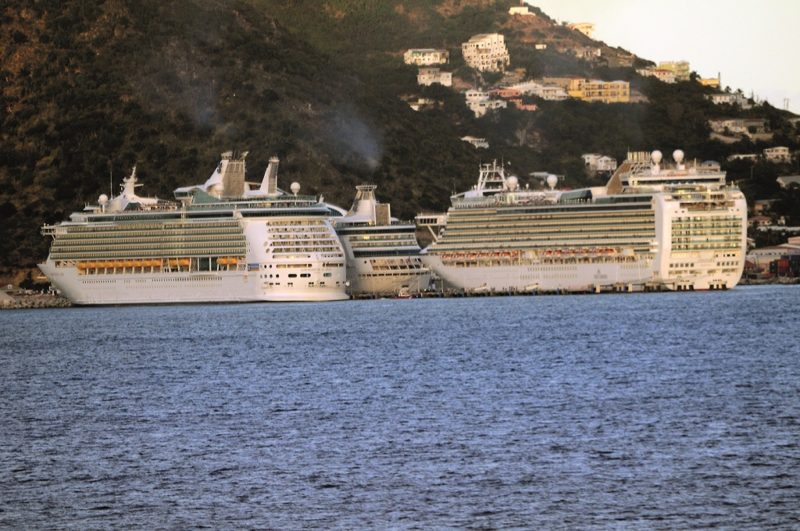
Anguilla (Spanish for eel) lies to the north, and the tiny Dutch cone shaped island of Saba to the south, with its Cable & Wireless repeater station on the top of its Mount Scenery 2,400 feet in height cone peak to carry telecommunications traffic up and down the Leeward and Windward Islands. These are the only other two islands left of the much greater island. The three islands of St. Martin/St. Maarten, Anguilla and Saba cover only 250 km2 of land.
The position of St. Martin/St. Maarten in the Eastern Caribbean is at 63º05′ West, 1º01′ North, with the island having a Hot Tropical climate with high summer time temperatures every day of the year. English is spoken in all shops and public buildings, and the dual nationality adds that variety and spice to a holiday or cruise to a real gem of an island set in the Caribbean Sea. There are regular passenger launch services to the nearby more populated island of Anguilla, those from the French side at Marigot Bay run every 45 minutes from 0815 hours to 1900 hours, and those from the Dutch side at a wharf at Simpson Bay run from 0900 hours to 1700 hours. Tiny Saba also has passenger launch services, but with a very small population on Saba these are only four times per week from Simpson Bay to Fort Bay Harbour on the south coast of Saba.
INTERNATIONAL CRUISE SHIP PORT
St. Martin/St. Maarten is similar to Charlotte Amalie on St. Thomas, with both being bustling cruise ship ports of call and with airports that can handle the huge numbers of large aircraft arriving every day. The attractions are, of course, self-evident with turquoise seas, beautiful bays and resorts with white or yellow sand, and to a certain extent they are superior to the best of the Mediterranean resorts. All cruise ships, with a maximum of eight being able to berth at the twin piers each day, turn to point their bows seaward on arrival and reverse in, so that they can put to sea with engines running forward in an easier departure. The huge and spectacular increase in passenger numbers over the last forty years is given in the following table:-
Year Cruise Passengers
Calls (Millions)
1980 32 0.105
1995 98 0.565
1999 102 0.616
2000 154 0.868
2001 155 0.860
2002 268 1.055
2003 332 1.171
2004 411 1.348

2005 488 1.488
2006 476 1.422
2007 477 1.422
2008 431 1.346
2009 411 1.215
2010 465 1.513
2011 499 1.656
2012 551 1.753
2013 631 1.786
2014 692 2.002
2019 734 2.128
The island cruise ship calls stopped from March 2020 due to the COVID-19 pandemic and for the remainder of 2020, and only began to slightly pick up in the second half of 2021 with only a few cruise ships operating worldwide. The Dutch Navy support ship Karel Doorman arrived at St. Maarten on 13th April 2000 from Den Helder to help the civilian authorities in the fight against COVID-9. She was last on the island in 2017 for some months to help with clearing up the devastation caused by hurricanes Irma and Maria.
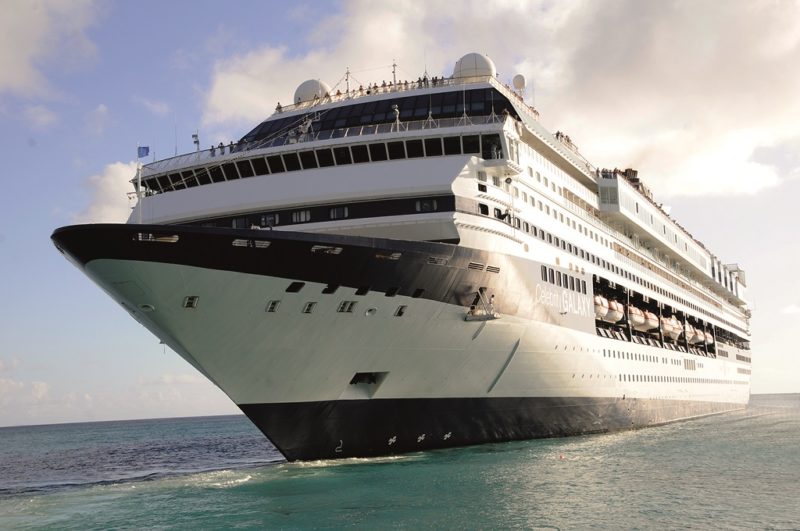
A mere 75,572 cruise passengers arrived in the port in November 2021, with four homeported ships arriving with the majority of passengers. These were Star Flyer of Star Clipper Cruises, Wind Surf of Windstar Cruises, Seabourn Odyssey of Seabourn Cruises, and the new MSC Seaview with a huge passenger capacity of 5,079 and carrying a crew of 1,412. Passenger numbers for December 2021 and the important Christmas and New Year season were beginning to pick up at 60 cruise ship calls with around 100,000 to 110,000 passengers. The cruise passenger total for the year of 2021 was 200,000 less than 10% of the year total in 2019.
Cruise ship lines calling in December 2021 included Carnival Cruise Line, Royal Caribbean International (RCI), Regent 7 Seas Cruises, Celebrity Cruises, Windstar Cruises, Star Clipper Cruises, MSC Cruises, Azamara Cruises, Crystal Cruises, Aida Cruises, Viking Ocean Cruises, Norwegian Cruise Line (NCL), Holland America Line, TUI Cruises, P. & O. Cruises, Cunard Line, Marella Cruises, and Oceania Cruises.
Extra unscheduled cruise calls can arrive at any time when Hurricane Force winds are expected in the Western or Eastern Caribbean cruise ship circuit. During the week from 14th August to 21st August 2017, the cruise ships Norwegian Escape and Disney Fantasy made unscheduled calls at St. Maarten after a change of itinerary due to severe weather in the vicinity of Belize, and also due to damage being caused to the cruise berths at Tortola (British Virgin Islands) by tropical storms. In the same week, the Simpson Bridge and the Causeway Bridge that allow yachts and small craft to enter and berth at the Simpson Bay Lagoon on the island were closed to traffic after hurricanes threatened the island to the north. These bridges are controlled by the Simpson Bay Lagoon Authority (SLAC), and are not designed to be opened for yachts to enter or exit in wind speeds above 25 miles per hour. Due to many less tourist craft on the island during the COVID-19 pandemic in 2020/21, these bridges only opened twice a day from 27th March 2021 at 0900 and 1400 hours. Yacht mariners were advised to check the times on the VHF-12 radio channel.
The island is on the main East Caribbean cruise ship circuit, taking in most of the Leeward Islands and Windward Islands including Puerto Rico, Antigua, Barbuda, St. Croix, St. Thomas, St. Maarten, Guadeloupe, Dominica, Martinique, St. Lucia, St. Vincent, Grenada, with Trinidad & Tobago lying south of the last Windward Island of Grenada.

ST MAARTEN CONTAINER AND CARGO HUB PORT
The Capt. David Cargo Port at St. Maarten consists of two adjacent quays of 270.0 metres in length to give a total of 540 metres of quay for cargo operations. The equipment used is twin Gottwald HMK 260 mobile cranes of 100 tonnes lift capacity, several reach stackers, top lifters, yard mules, fork lifts, and a large fleet of trucks and chassis trailers. The container storage yard is triangular in shape and cut into the cliffs of the Pointe Blanche peninsula to the east of the twin cruise ship berths. The warehouse is of 444m2 in area and there are two ro-ro berths at the southern and northern ends of the quays, together with a small inter-island quay serving the region to the neighbouring islands of Anguilla, Montserrat, St. Barts, St. Kitts & Nevis, and Antigua and Barbuda. St. Maarten Shipping & Stevedoring N.V. and St. Maarten Port Services carry out cargo handling, container stuffing and destuffing, container repair, warehousing and logistics services.
The container annual throughput is 95,000 TEU plus a much smaller number of ‘800’ series special small sized containers, together with imports of 80,000 tonnes of sand, 60,000 tonnes of cement, and 30,000 tonnes of gravel per year for use by the island construction industry. Cement is imported in cement carriers such as NACC Panarea of 5,800 dwt on dimensions of overall length of 102 metres, moulded beam of 17 metres and built in 2007 with a large ‘midships cement mixing structure for NACC Shipping of Canada. Petrol and heating fuel arrives in coastal tankers such as the British registered Veronica PG of 10,632 dwt and built in 2004 as Topa.
A deep sea service to the island is operated by CMA-CGM on its Nefgui service from Northern Europe to French Guiana and North Brazil, and calling at Philipsburg and Port of Spain enroute, and there are also calls by a number of Caribbean feeder shipping lines. The CMA CGM Nefgui service is operated in conjunction with Marfret of France, using six container ships of between 2,150 and 2,300 TEU capacity, built in 2015, named CMA CGM Cayenne, CMA CGM Kourou, CMA CGM Marseille, CMA CGM Saint Laurent, CMA CGM Sinnamary, and Douce France of Marfret Lines. These six are geared container ships equipped with cranes of 40 tonnes capacity, with the northern loading ports being Rotterdam, London Gateway and Le Havre, and the southern terminal ports being Degrad des Cannes in French Guiana, and Vila do Conde, Fortaleza and Natal in Northern Brazil. A call at the Southern Europe major container port of Algeciras in Spain is made on the return circuit.

The Nefgui service of a 42 day cycle connects with the CMA CGM Leewards ro-ro service running to all of the Leeward and Windward Islands from San Juan (Puerto Rico) to Port of Spain (Trinidad), and operated by the green hulled freight ro-ro Mimer of 5,873 grt and completed in 1990 by the J.J. Sietas yard at Neuenfelde as Bore Star for Bore Lines of Finland, before she became Mimer in 1993 for Transfennica for Baltic Sea freight routes. She has a service speed of fifteen knots from a single Wartsila 9R332D diesel engine with 1,032 lane metres of space on her freight deck, and with dimensions of overall length 108.35 metres and moulded beam of 17 metres and a loaded draft of 5.97 metres. CMA CGM Leeward Islands feeder container ship calls by Cedric K of 3,482 grt, and built in 2004 with twin portside cranes, include from San Juan on Puerto Rico to St. Maarten, St. Barts, Charlotte Amalie, Road Town on Anguilla, Christiansted on St. Croix, Basse Terre and Pointe a Pitre on Guadeloupe, and also Fort de France on Martinique. The CMA CGM Nefgui service also links up at Rotterdam with the deep sea FAL Far East, FEMEX and NAF services, and at Le Havre with the FAL, EPIC, NCX, ECS, PCRF, Arc Atlantique as well as feeders to Southern Ireland, and at Port of Spain (Trinidad) with the Guyanas, Nord Brazil, Caribraz, Brassex, Pex and CMA CGM Cagema services.
The CMA CGM Cagema service has a 21 day cycle from St. John (NB) to New York, Kingston (Jamaica), Caucedo and Rio Haina in the Dominican Republic, Cartagena (Colombia), Philipsburg and Port of Spain (Trinidad), San Juan (Puerto Rico) and return to Canada. Three container ships of 1,338 TEU capacity are used, namely AS Filippa, SC Marigot, and Polynesia with 449 reefer plugs. Three feeder ships are also used on the CMA CGM Central America Express service calling at many Caribbean ports from Central American ports, these feeder ships are BF Leticia, Janina and Nadja.
There are also regular container feeder services and refrigerated containers fruit services that call at Philipsburg by Seatrade of Groningen, Tropical Shipping of Miami, King Ocean Services, Seaboard Marine Lines of Miami, Crowley Liner Services Inc., and freight forwarding companies to the Dutch Antilles ‘ABC’ islands of Aruba, Bonaire and Curaçao.

These are now given in more detail.
Seatrade of Groningen have a long history dating back to 1951 when five Dutch captain owners formed a co-operative as N. V. Scheepvaarts Groningen. Seatrade Groningen was set up in 1973 and took over Dammers & Van der Heide in 1989, Triton Shipping Gmbh in 1994, United Reefers in 2005, and Amer Shipping in 2008. A quartet of exact sisters call monthly at Philipsburg in Seatrade Orange, Seatrade Red, Seatrade Blue and Seatrade White of 2,259 TEU and completed at Yangfan in China in 2016/17. They measure 180 metres overall length, 19 metres moulded beam, 16.5 metres moulded depth and 9 metres loaded draft and 25,175 grt, 27,366 dwt with 13,480 pallets of fruit in a full cargo. They have a service speed of 19.0 knots from a six cylinder M.A.N. – B&W diesel engine of 17,800 bhp.
Tropical Shipping was founded in 1963 by John Holmes Birdsall. He started with a vessel of only 120 feet in length to transport heavy equipment from his West Palm Beach based construction business to the Bahamas. Tropic Ace made her maiden voyage to Freeport in the Bahamas carrying machinery and building supplies. Today, Tropic Shipping is one of the biggest tenants of West Palm Beach warehouses as it is a North American logistics provider from Canada to South Florida. All types of TEU sized containers are carried on a forty strong fleet of feeder container ships, as well as less then TEU sized special ‘Tropbox’ containers. A fire at its St. Maarten warehouse on 3rd May 2018 only briefly stopped services on the vessel Tropic Lissette of 1,145 TEU, completed in 2018 with a service speed of 18 knots. She calls at Philipsburg and also calls at Road Bay on Anguilla, Bridgetown on Barbados, St. Croix and St. Barts from Palm Beach. Tropic Unity and Tropic Carib call at Philipsburg, St. Kitts, Antigua and Barbuda from Palm Beach, while Tropic Hope calls at Philipsburg, Grenada, and Port of Spain from Palm Beach.
King Ocean Services cover a large area of the Caribbean, Central and South America with feeder container services using forty chartered or owned vessels. The blue hulled vessel AS Letitia runs on Leeward and Windward Islands services, and measures 139 metres overall length, 23 metres moulded beam, and has a loaded draft of 7.7 metres and was completed in 2007 of 11,850 dwt. She uses two yellow container cranes positioned on her port side to load and discharge containers at Caribbean islands with little infrastructure. Project cargo, refrigerated cargo and special less than TEU sized containers known as the ‘800’ series of containers are carried. Bernuth Lines was added on 7th September 2012 to the existing operations of King Ocean Services with services to St. Maarten, Anguilla, Barbados, Dominica, St. Kitts & Nevis, Montserrat, St. Barts, Grenada, St. Vincent, St. Lucia, Trinidad, Guyana, Suriname, the Dominican Republic, Nicaragua and San Andres (Colombia).
Seaboard Marine Lines was established in Miami in 1983 and today serves the regions of North America, Caribbean Basin and Central and South America from a 170,000 square feet in area warehouse in Miami. A fleet of around thirty feeder container ships serve almost forty ports, with a five day service to Philipsburg on St. Maarten, and longer services to Bridgetown (Barbados), Cartagena (Colombia), El Salvador, Port au Prince (Haiti), Honduras, Kingston (Jamaica), Surinam and Port of Spain (Trinidad). The feeder container ships Seaboard Atlantic, Seaboard Explorer, Seaboard Ocean, Seaboard Patriot, Seaboard Ranger and Seaboard Sun carry a range of dry cargo, refrigerated cargo, project cargo, specialised cargo, and a range of TEU containers including High Cube, Series ‘800’ containers, as well as Less than Container Loads (LCL).
Crowley Liner Services Inc. today operate ro-ro services to the Caribbean ports of Costa Rica, Guatemala, Honduras, San Juan on Puerto Rico, Montego Bay and Kingston on Jamaica as well as Dutch Antilles Curacao and St. Maarten. Crowley was established in 1892 when Thomas Crowley rowed supplies to sailing ships anchored in San Francisco Bay, and soon expanded from chandlery into the towage of ships. Four steam powered wooden tugs and several derrick barges were added to the fleet by 1924, with later expansion into Puget Sound. By 1946, the company operated derrick barges, dredgers and tugs in the harbours of Los Angeles, Long Beach and San Diego. Oil barges were built for charter to Shell for use in Southern California, and later Crowley became a very major provider of services to the Alaskan oil fields.
Crowley began in 1971 a ro-ro barge cargo service between Miami and Jacksonville to San Juan on Puerto Rico. Three container ships were built by the Odense yard in Denmark in 1984/85 named Sea Wolf, Sea Fox and Sea Lion of 643 feet overall length and 2,200 TEU capacity to include reefer plugs, smaller sized containers, and thirty trailers. They served along with three chartered container ships on charter to U. S. Lines from ports such as Lake Charles in Louisiana and other U.S. Eastern Seaboard and Gulf ports to Venezuela, Trinidad, Guyana, Brazil, Uruguay and Argentina. A wide range of Alaskan services are also operated today from San Diego, Los Angeles, Long Beach, San Francisco, Coos Bay (Oregon) and Puget Sound to Alaskan ports.
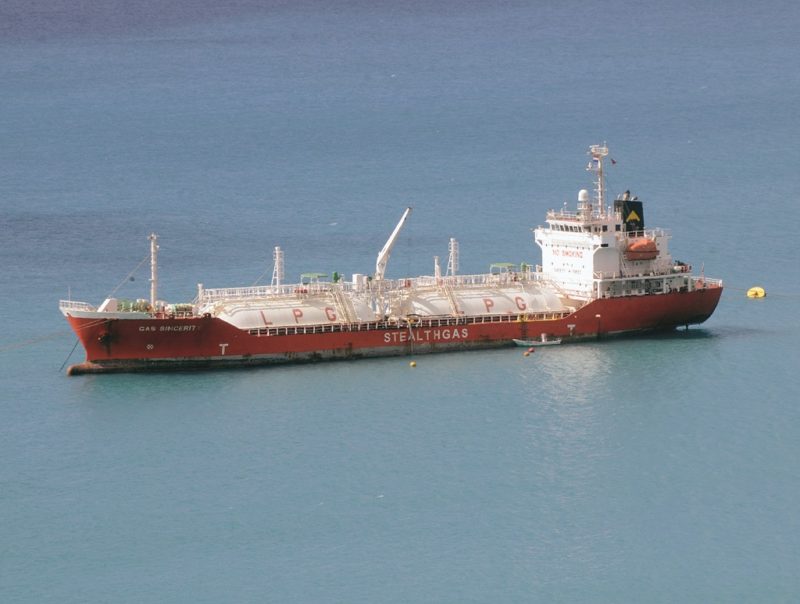
INTER-ISLAND VESSELS, SAIL TRAINING SHIPS and MEGA YACHTS
Seven Castle Shipping use a forward ramp loading landing craft named Orion of 764 grt and 824 dwt for a weekly service to Saba, St. Eustatius, St. Kitts & Nevis and St. Barts. She was built in Greece in 1979 on dimensions of length 70 metres and beam of 13.6 metres and is powered by twin Mercedes Maybach diesel engines of a total 2,850 bhp. The schedule is St. Maarten (Tuesday), Saba (Wednesday), St. Kitts & Nevis (Thursday), St. Eustatius and St. Barts (Friday). There are also project cargo shipments to Anguilla for on-going construction work. Islands such as the little developed British island of Dominica need inter-island vessels from St. Maarten, as Roseau has extremely basic port facilities to unload containers and lighter weight cargoes, using a former offshore supply vessel, Mutty’s Pride of 651 grt and built in 1979. Dominica has no international airport, and tourists arrive on this beautiful, unspoilt island by light planes from the international airport on Barbados, an interesting way to begin a holiday.
The Dutch three masted sail training ship Stad Amsterdam of 723 grt is a frequent visitor to Philipsburg and St. Maarten. She berths at the quays near the entrance to the twin cruise ship piers, or if there is space on the cruise ship piers. She was completed in 2000 by Damen at Amsterdam with a black clipper hull and a thin white line on a hull of 67 metres overall length and a moulded beam of 11 metres. She was designed by Gerrard Dijkstra on the lines and style of the middle of the 19th century Dutch ship of the same name. She won the 2001 Cutty Sark Tall Ships Race by a good time margin in some style, and is normally the flagship of the Sail Amsterdam fleet at Amsterdam as she can hoist a good spread of twenty sails.
Yacht sailing events are hosted all year round in the Bay at Philipsburg, with the main sailing event being the St. Maarten Heineken Regatta held every year since 1980 during a two week Carnival Festival, with usually 500 to 600 small and large sailing yachts in port at the Simpson Bay Lagoon berths or other berths at Marigot Bay on the west French side of the island. However, visiting mega motor yachts such as Big Eagle of 172 feet overall length with nine crew and cabins for a dozen guests, and the mega motor yacht Fortunate Sun of 177 feet overall length with a dozen crew and cabins for ten guests, have to berth at the windjammer quays near the twin cruise ship piers. The sleek black hulled Atseeba IV, Ectasea and My Axioma mega motor yachts are of the same size, and the giant sailing yacht VO65 with Team Brunel is a frequent winner in the large sized yacht races.
On a smaller scale, water taxis are available at three small public quays of Capt. Hodge Wharf, Walter Williams Jetty, and Bobby’s Marina, at one end of the white sand Great Bay of Philipsburg for various coastal trips, and a public bus service runs from Philipsburg to Marigot Bay and Grand Case in the west and north of the French part of the island. Island hopping can be exhilarating on a highspeed ferry to St. Barts, or by small single engine aircraft.
The best time to visit St. Martin/St. Maarten is during December through to April as the heat is less oppressive with all of the carnivals and sailing regattas taking place during this season. High humidity builds up in May and does not dissipate until late November and the tropical hurricane season with sometimes devastating damage occurs between June and October.

THE DUTCH ANTILLES SHIP REGISTER
This ship registry was separate from the much larger Netherlands Ship Register, and had only 97 smaller ships on its register of 894,479 grt in 1998, compared to two thousand on the Netherlands Ship Register. All of the islands of the Dutch Antilles were reorganised into different groupings on 10th October 2010 with the Netherlands Antilles Ship Register renamed as the Curacao Ship Register. This had followed a self -determination free vote on each of the Dutch Caribbean islands including St. Maarten between June 2000 and April 2005. St. Maarten, Aruba and Curaçao voted for independence, Saba and Bonaire voted for closer ties with the Netherlands, and St. Eustatius voted to stay within the Dutch Antilles.
Vessels under the Dutch Antilles flag included Holland America Line cruise ships, reefers of the Dammers & Van der Heide and Seatrade Groningen fleets, Shell deep-sea tankers and Shell coastal tankers Karet, Koraal and Passaat of 290 grt built between 1957 and 1967, St. Maarten and St. Eustatius fishing trawlers, and Smit International (Antilles) N.V. tugs. Four interesting Dutch Antilles Ship Register vessels will now be examined in more detail.
Firstly, Antilla of 472 grt was a Government of the Dutch Antilles coaster that was completed in November 1954 by the Van Diepen yard at Waterhuizen in Holland. She had her bridge and machinery aft with dimensions of overall length 210.4 feet, moulded beam of 30.8 feet, moulded depth of 17.7 feet, and a loaded draft of 10.5 feet. She had a rivetted and welded hull with a fo’c’stle of length 35 feet and a poop deck of length 39 feet. She was used on a regular service to carry passengers, food and Government stores from her base at Willemstad on Curacao to the Northern Dutch Antilles islands of St. Maarten, Saba, and Statia as well as to St. Kitts. A seven cylinder 4SA Werkspoor diesel engine gave a service speed of 12 knots on these voyages. She gave over twenty years of service to the Government of the Dutch Antilles until she was sold off in 1976 to Pedonomou Line with her name unchanged. In 1977, she was renamed Kalisten-Mihalis by Andreas Line Ltd. of Georgetown (Cayman Islands) and was broken up three years later in 1980.
Secondly, NAZ (Nederlandsche Antillaans Zeevaart Institut) was responsible for the seafaring training in small groups of five or six young men from the Dutch Antilles islands of Curacao, Bonaire, Aruba, St. Maarten, Saba and Statia (St. Eustatius). The latter island is of the same tiny size as Saba but lies to the south east of Saba and is topped by the dormant volcano ‘The Quill’, with Oranjestad as its port and town. The island was made a tax-free haven in 1756 by the Dutch and became the most popular port of call between Europe and the Caribbean. NAZ decided to purchase, with a grant from the Dutch Antilles Government, the former heavy lift ro-ro Thor Scan built in 1982 by the Martin Jansen yard at Leer of 7,591 grt and 9,800 dwt for the training purpose. She had a crew of twenty and a service speed of fifteen knots from a six cylinder Krupp diesel engine.
On 25th August 2006, Thor Scan was renamed Karla-Omayra in the presence at Tuzla in Turkey of two Ministers of the Kingdom of the Netherlands, Karla Peys and Omayra Leeflang. The ro-ro ship was undergoing a thorough refit at Tuzla with the hull and other areas of the ship sand blasted and repainted, and with two new replacement container lifting cranes on the starboard side. Five Dutch Antilles students were on the ship throughout the refit that lasted until the end of 2006, the students were employed with hammers and paint brushes during the daytime and navigational training in their cabins at night. Romeo, Dominique, Jorgen, Merwin and Joseph were the first five students, and it was planned to use the ship in a pilot scheme to train small groups of young men from St. Maarten, Saba, Statia and the ‘ABC’ Dutch Antilles islands.
Karla-Omayra was used on worldwide commercial voyages by NAZ e.g. she loaded cargo at St. Maarten and Fort de France on Martinique on 21st to 24th December 2007, having sailed down from Davisville on Rhode Island on 12th December 2007. She was then at Koper (Croatia) in May 2008 where she loaded pipes for Iraq, and at Genoa on 25th August 2008. She was arrested in the anchorage at Singapore on 28th March 2009 for unpaid wages and low food rations for 15 seafarers and four trainees. The trainees were repatriated, and she was then renamed after her release from arrest by NAZ and her managers ShoreNAZ in September 2009 at Singapore as PWP and later PWP1, and was later broken up some time after 2013.
Thirdly, the Dammers & Van der Heide refrigerated engines aft cargo ship Swalan, which had been built as Laura Christina in 1978 of 2,989 grt and 3,501 dwt and renamed Swalan in April 1990, and is still trading today as Leelawadee Reefer. Fourthly, the general cargo ship Ahora of 5,261 grt and 6,838 dwt, which had been built in 1963 for the Finland Steamship Co. Ltd. as Argo with a sister Virgo by the Rauma Repola yard in Finland with five hatches, four forward of the navigating bridge and one aft. She was lengthened in 1970 and renamed Leenor in 1981 and Ahora in 1989, and is still in service as the S Leelawadee for Krung Siam Maritime of Thailand.
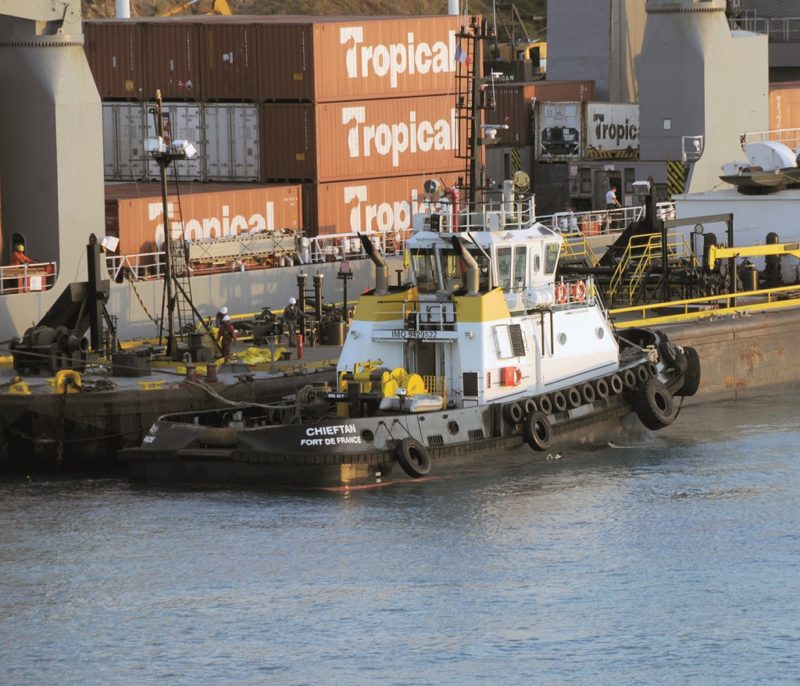
TOWAGE AT ST. MAARTEN and ST. EUSTATHIUS
Towage services at St. Maarten are provided by two former Tees Towing Company tugs, in Coatham Cross built in 1981 by Richard Dunston Ltd. at Hessle on the Humber, and which arrived at Grenada in the Caribbean in 2014 as La Dani of 2,660 bhp and 35 tonnes bollard pull, and Norton Cross built in 1985 by the same builder, and which arrived in the Caribbean having been renamed on the Tees in 2016 as Midgard Max of 3,400 bhp and 40 tonnes bollard pull. The two former Tees tugs work together as fore tug and aft tug for many of the ship arrivals and departures at St. Maarten.
A very large 2.2m3 or a huge 14 million barrels of oil storage facility is located on St. Eustatius to the south of St. Maarten near St. Kitts & Nevis and was opened in 1982. Storage, blending, processing and other terminal activities for crude oil, refined products and other bulk liquids are performed on oil stored in 72 tanks at high ground in the north of this tiny island with a population of only 3,500. The marine assets include a very long pier for ULCC, VLCC and Aframax tankers to load and unload, as well as a Single Point Mooring (SPM), a Monopile with two mooring locations, and a Floating Hose Station for oil barges. This is one of the largest oil storage locations in the Caribbean, with others owned by Glencore and Hess Oil on St. Lucia, and handles over 90 million barrels of oil per year. It is owned by GTI Statia, with their other owned oil refineries and storage facilities at Europort in Rotterdam and at Point Tupper in Eastern Canada.
Towage is performed by two Svitzer owned tugs, Statia Condor and Statia Reliant, built in 2008 in Spain of 65 tonnes bollard pull on a contract that was extended by three years from May 2020. Other vessels that have been based at St. Eustatius in recent years include the supply ship Statia Responder of 998 grt built in 1976 and fitted at the stern with a long jib yellow crane, however she has been laid up at Port of Spain since April 2018.
A class of five tugs built by the Zamakona yard at Bilbao in 2006/08 for Seabulk Towing Services Inc. of Fort Lauderdale in Statia Express, Statia Glory, Statia Sunrise, Statia Reliant and Statia Caroni of 284 grt, 4,000 bhp and 50 tonnes bollard pull, are also based and used at St. Eustatius to work with five large oil barges, each of 4,250 grt and a capacity in ten tanks of 52,000 barrels of oil. These tug and barge combinations are often seen at St. Maarten, supplying cruise ship bunkers via supplier Caribbean Fuels, and at other Caribbean oil terminals as Terminal Support Tugs.
PORT OF ST. MAARTEN ADMINISTRATION
The very modern Head Office at Philipsburg of the Port of St. Maarten is on a dry island in the middle of the former Great Pond Lake, used for centuries in the extraction of salt. The Port of St. Maarten is controlled by the St. Maarten Harbour Holding Company led by a Chief Executive Officer, and a Chief Commercial Officer, Chief Financial Officer, Human Resources and Personnel Officer, Harbour Master, Terminal and Cargo Handling Officer, as well as Maintenance, IT and Security and Safety Departments.
The Port of St. Maarten hosted around four hundred cruise ships during 2022, of which ten were in port during the St. Maarten Carnival running from 16th April to 3rd May. This will restore the image of the port as a major cruise destination, giving the highest number of cruise ship calls per year for three years.
Transhipment of containers, and particularly of yachts and project cargo carried on heavy lift ships, is also on the increase to the neighbouring islands, with Philipsburg set to play a much greater role in the shipping needs of the Leeward Islands. The current alongside depth of the Capt. David Cargo Terminal quays is 10.5 metres, with plans to increase this depth to 12 metres when bigger and deeper ships shortly begin to arrive.

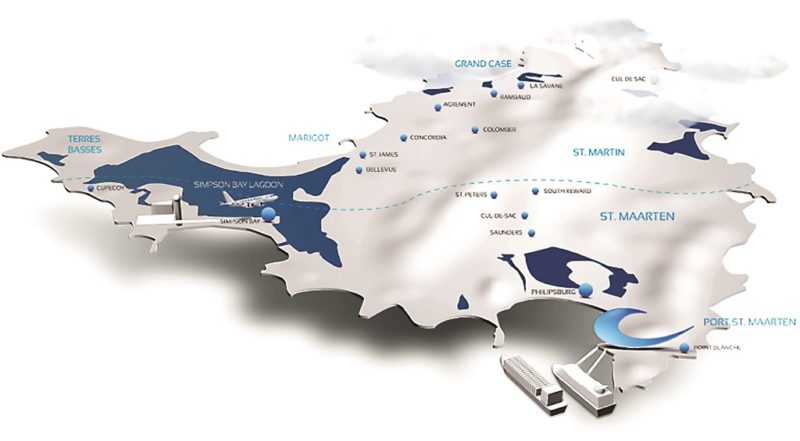




Comments
Sorry, comments are closed for this item